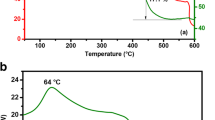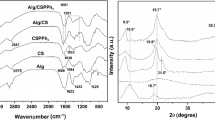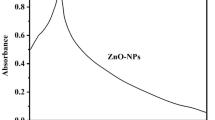Abstract
Purpose
Modified biopolymers have attracted considerable attention in water treatment recently due to the natural availability, environmental compatibility, cheap price etc.
Methods
In the present study, Chitosan Nanoparticles-Alginate/ Methyl Acrylate (CS NPs-Alg/MA) beads were prepared. They successfully applied as an adsorbent in the process of removing harmful Pb2+ ions from their aqueous solutions. SEM, EDX, and FTIR studies to characterize the structure of the modified materials before adsorption were used. Varied factors of Pb2+ ions adsorption including contact time, pH of solutions, adsorbent dosage, and initial concentration of the metal ions were studied for optimizing the adsorption efficiency of the (CS NPs-Alg/MA) beads.
Results
According to the findings, the equilibrium uptake increased as the metal ion concentration increased, and the maximum adsorption capacity found to be 80.6 mg/g for Pb2+ ions. In addition, kinetics and isotherms were applied to the process of adsorption to understand better the fundamentals underlying this process and how it occurs. R2 values for Langmuir isotherm model (R² = 0.9998) were greater than those for Freundlich model’s correlation coefficients (R² = 0.823). Therefore, it was evident that Langmuir model adequately explained Pb2+ ions adsorption onto CS NPs-Alg/MA adsorbent. Moreover, the kinetics of the adsorption was consistent with a pseudo-second-order model. The prepared beads were regenerated well using a dilute acidic solution and still maintained good adsorption capacity after regeneration.
Conclusions
The synthesized (CS NPs-Alg/MA) beads can be a successful adsorbent for Pb2+ ions from their aqueous environment.










Similar content being viewed by others
Data Availability
The data That support the findings of this article are available upon request from the corresponding author [Korany A. Ali].
References
Basu H, Singh S, Venkatesh M, Pimple MV, Singhal RK (2021) Graphene oxide-MnO2-goethite microsphere impregnated alginate: a novel hybrid nanosorbent for as (III) and as (V) removal from groundwater. J Water Process Eng 42:102129. https://doi.org/10.1016/j.jwpe.2021.102129
Elanchezhiyan SSD, Karthikeyan P, Rathinam K, Farzana MH, Park CM (2021) Magnetic kaolinite immobilized chitosan beads for the removal of pb(II) and cd(II) ions from an aqueous environment. Carbohydr Polym 261:117892. https://doi.org/10.1016/j.carbpol.2021.117892
Liu R, Zhang Y, Hu B, Wang H (2022) Improved pb(II) removal in aqueous solution by sulfide@biochar and polysaccharose-FeS@ biochar composites: efficiencies and mechanisms. Chemosphere 287:132087. https://doi.org/10.1016/j.chemosphere.2021.132087
ALSamman MT, Sa´nchez J (2021) Recent advances on hydrogels based on chitosan and alginate for the adsorption of dyes and metal ions from water. Arab J Chem 14:103455. https://doi.org/10.1016/j.arabjc.2021.103455
Khadija D, Hicham A, Rida A, Hicham E, Nordine N, Najlaa F (2021) Surface water quality assessment in the semi-arid area by a combination of heavy metal pollution indices and statistical approaches for sustainable management. Environ Challenges 5:100230. https://doi.org/10.1016/j.envc.2021.100230
Yan C, Qu Z, Wang J, Cao L, Han Q (2022) Microalgal bioremediation of heavy metal pollution in water: recent advances, challenges, and prospects. Chemosphere 286:131870. https://doi.org/10.1016/j.chemosphere.2021.131870
Wan J, Zhang F, Han Z, Song L, Zhang C, Zhang J (2021) Adsorption of Cd2+ and Pb2+ by biofuel ash-based geopolymer synthesized by one-step hydrothermal method. Arab J Chem 14:103234. https://doi.org/10.1016/j.arabjc.2021.103234
Agasti N (2021) Decontamination of heavy metal ions from water by composites prepared from waste. Curr Res Green Sustainable Chem 4:100088. https://doi.org/10.1016/j.crgsc.2021.100088
Raghavendra N, Hublikar NM, Koujalagi LV, Prabhu SB, Mahale S N (2023) Evaluation of PANI-Averraoha bilimbi leaves activated carbon nanocomposite for Cd2+ and Pb2+ removal from wastewater. J Indian Chem Soc 100:100872. https://doi.org/10.1016/j.jics.2022.100872
Li L, Yang B, Ji G, Zhao Z, Zhang H, Wang F, Xia M, Huang P (2023) Mg/Al layered double hydroxides intercalated with ethylenediamine-tetramethylene phosphonic acid for efficient removal of Pb2+ and Cd2+ ions and the intercalation mechanism study. Colloids Surf a 675:132087. https://doi.org/10.1016/j.colsurfa.2023.132087
Huda BN, Wahyuni ET, Kamiya Y, Mudasir M (2022) Kinetic and thermodynamic study on adsorption of lead (II) ions in water over dithizone-immobilized coal bottom ash. Mater Chem Phys 282:126005. https://doi.org/10.1016/j.matchemphys.2022.126005
Gao C, Wang X-L, An Q-D, Xiao Z-Y, Zhai S-R (2021) Synergistic preparation of modified alginate aerogel with melamine/ chitosan for efficiently selective adsorption of lead ions. Carbohydr Polym 256:117564. https://doi.org/10.1016/j.carbpol.2020.117564
Chwastowski J, Staron P (2022) Influence of Saccharomyces cerevisiae yeast cells immobilized on Cocos nucifera fibers for the adsorption of pb (II) ions. Colloids Surf a 632:127735. https://doi.org/10.1016/j.colsurfa.2021.127735
Wang R, Xu B, Chen Y, Yin X, Liu Y, Yang W (2022) Electro-enhanced adsorption of lead ions from slightly-polluted water by capacitive deionization. Sep Purif Technol 282:120122. https://doi.org/10.1016/j.seppur.2021.120122
Sheth Y, Dharaskar S, Khalid M, Sonawane S (2021) An environmentally friendly approach for heavy metal removal from industrial wastewater using chitosan based biosorbent: a review. Sustain Energy Technol Assess 43:100951. https://doi.org/10.1016/j.seta.2020.100951
Lingamdinne LP, Godlaveeti SK, Angaru GKR, Chang Y-Y, Nagireddy RR, Somala AR, Koduru JR (2022) Highly efficient surface sequestration of Pb2+ and Cr3+ from water using a Mn3O4 anchored reduced graphene oxide: selective removal of Pb2+ from real water. Chemosphere 299:134457. https://doi.org/10.1016/j.chemosphere.2022.134457
Ponnusami AB, Sinha S, Ashokan H, Paul MV, Hariharan SP, Arun J, Gopinath KP, Le QH, Pugazhendh A (2023) Advanced oxidation process (AOP) combined biological process for wastewater treatment: a review on advancements, feasibility, and practicability of combined techniques. Environ Res 237:116944. https://doi.org/10.1016/j.envres.2023.116944
Usman UL, Singh NB, Allam BK, Banerjee S (2022) Plant extract mediated synthesis of Fe3O4-chitosan composite for the removal of lead ions from aqueous solution. Mater Today: Proc 60:21140–21149. https://doi.org/10.1016/j.matpr.2022.02.311
Farahani FV, Amini MH, Ahmadi SH, Zakaria SA (2021) Investigation of layered double hydroxide/carbon dot nanocomposite on removal efficiency of Pb2 + from aqueous solution. J Mol Liq 338:116774. https://doi.org/10.1016/j.molliq.2021.116774
Liu D, Xu S, Cai Y, Wang Y, Guo J, Li Y (2022) A coupling technology of capacitive deionization and carbon-supported petal-like VS2 composite for effective and selective adsorption of lead (II) ions. J Electroanal Chem 910:116152. https://doi.org/10.1016/j.jelechem.2022.116152
Siddiqui MN, Pervez S, Karbhal I, Dugga P, Rajendran S, Pervez YF (2022) Using functionalized asphaltenes as effective adsorbents for the removal of chromium and lead metal ions from aqueous solution. Environ Res 204:112361. https://doi.org/10.1016/j.envres.2021.112361
Maheswari BU, Sivakumar VM, Thirumarimurugan M (2022) Sequester adsorption of cr(VI) and pb(II) ions from aqueous solution by green synthesized nanocomposite (OB/ZnO): characterization, kinetics, isotherm, and mechanism. Environ Nanatechnol Monit Manage 18:100680. https://doi.org/10.1016/j.enmm.2022.100680
Mao S, Gao M (2021) Functional organoclays for removal of heavy metal ions from water: a review. J Mol Liq 334:116143. https://doi.org/10.1016/j.molliq.2021.116143
He P, Zhang Y, Zhang X, Chen H (2021) Diverse zeolites derived from a circulating fluidized bed fly ash based geopolymer for the adsorption of lead ions from wastewater. J Clean Prod 312:127769. https://doi.org/10.1016/j.jclepro.2021.127769
Lin X, Shen T, Li M, Shaoyu J, Zhuang W, Li M, Xu H, Zhu C, Ying H, Ouyang P (2022) Synthesis, characterization, and utilization of poly-amino acid-functionalized lignin for efficient and selective removal of lead ion from aqueous solution. J Clean Prod 347:131219. https://doi.org/10.1016/j.jclepro.2022.131219
Kulpa-Koterwa A, Ryl J, Górnicka K, Niedziałkowski P (2022) New Nanoadsorbent based on magnetic iron oxide containing 1,4,7, 10-tetraazacyclododecane in outer chain (Fe3O4@SiO2-cyclen) for adsorption and removal of selected heavy metal ions Cd2+, Pb2+, Cu2+. J Mol Liq 368:120710. https://doi.org/10.1016/j.molliq.2022.120710
Li H, Ji H, Cui X, Che X, Zhang Q, Zhong J, Jin R, Wang L, Luo Y (2021) Kinetics, thermodynamics, and equilibrium of as(III), cd(II), Cu(II) and pb (II) adsorption using porous chitosan bead supported MnFe2O4 nanoparticles. Int J Min Sci Technol 31:1107–1115. https://doi.org/10.1016/j.ijmst.2021.10.004
Srivastava V, Choubey AK (2021) Investigation of adsorption of organic dyes present in wastewater using chitosan beads immobilized with bio fabricated CuO nanoparticles. J Mol Struct 1242:130749. https://doi.org/10.1016/j.molstruc.2021.130749
Zhao Z, Huang Y, Wu Y, Li S, Yin H, Wang J (2021) α-ketoglutaric acid modified chitosan/polyacrylamide semi-interpenetrating polymer network hydrogel for removal of heavy metal ions. Colloids Surf a 628:127262. https://doi.org/10.1016/j.colsurfa.2021.127262
Javadian H, Ruiz M, Sastre AM (2020) Response surface methodology based on central composite design for simultaneous adsorption of rare earth elements using nonporous calcium alginate/carboxymethyl Chitosan Micro Bio composite powder containing Ni0.2Zn0.2Fe2.6O4 magnetic nanoparticles: batch and column studies. Int J Biol Macromol 154:937–953. https://doi.org/10.1016/j.ijbiomac.2020.03.131
Zhang W, Ou J, Wang B, Wang H, He Q, Song J, Zhang H, Tang M, Zhou L, Gao Y, Sun S (2021) Efficient heavy metal removal from water by alginate-based porous nanocomposite hydrogels: the enhanced removal mechanism and influencing factor insight. J Hazard Mater 418:126358. https://doi.org/10.1016/j.jhazmat.2021.126358
Ma H, Yang Y, Yin F, Zhang X-F, Qiu J, Yao J (2022) Integration of thermos responsive MIL-121 into alginate beads for efficient heavy metal ion removal. J Clean Prod 333:130229. https://doi.org/10.1016/j.jclepro.2021.130229
Njaramba LK, Kim S, Kim Y, Cha B, Kim N, Yoon Y, Park CM (2022) Remarkable adsorption for hazardous organic and inorganic contaminants by multifunctional amorphous core–shell structures of metal–organic framework-alginate composites. Chem Eng J 431:133415. https://doi.org/10.1016/j.cej.2021.133415
Liu M, Wen Y, Song X, Zhu J-L, Li J (2019) A smart thermos responsive adsorption system for efficient copper ion removal based on alginate-g-poly(N-isopropylacrylamide) graft copolymer. Carbohydr Polym 219:280–289. https://doi.org/10.1016/j.carbpol.2019.05.018
Zhao H, Ouyang X-K, Yang L-Y (2021) Adsorption of lead ions from aqueous solutions by porous cellulose nanofiber–sodium alginate hydrogel beads. J Mol Liq 324:115122. https://doi.org/10.1016/j.molliq.2020.115122
Wang Y, Li P, Tran TT-D, Zhang J, Kong L (2016) Manufacturing techniques and Surface Engineering of Polymer based nanoparticles for targeted drug delivery to Cancer. Nanomaterials 6:26. https://doi.org/10.3390/nano6020026
Roh H, Kim Y, Kim YK, Harbottle D, Lee JW (2019) Amino-functionalized magnetic chitosan beads to enhance immobilization of potassium copper hexacyanoferrate for selective cs + removal and facile recovery. RSC Adv 9:1106–1114. https://doi.org/10.1039/c8ra09386e
Liu D, Xu S, Cai, Wang Y, Guo J, Li Y (2022) A coupling technology of capacitive deionization and carbon-supported petal-like VS2 composite for effective and selective adsorption of lead (II) ions. J Electroanal Chem 910:116152. https://doi.org/10.1016/j.jelechem.2022.116152
Chen B, Li Y, Du Q, Pi X, Wang Y, Sun Y, Zhang Y, Chen K, Wang M (2022) Synthesis, characterization, adsorption properties and mechanism of gravity-assisted zirconium alginate hydrogel fiber for removal of methylene blue from water. Mater Today Commun 32:104004. https://doi.org/10.1016/j.mtcomm.2022.104004
Huang Y, Zheng H, Hu X, Wu Y, Tang X, He Q, Peng S (2022) Enhanced selective adsorption of lead (II) from complex wastewater by DTPA functionalized chitosan-coated magnetic silica nanoparticles based on anion-synergism. J Hazard Mater 422:126856. https://doi.org/10.1016/j.jhazmat.2021.126856
Punia P, Aggarwal RK, Kumar R, Dhar R, Thakur P, Thakur A (2022) Adsorption of cd and cr ions from industrial wastewater using ca doped Ni–Zn nano ferrites: synthesis, characterization, and isotherm analysis. Ceram Int 48:18048–18056. https://doi.org/10.1016/j.ceramint.2022.02.234
Najafi M, Bastami TR, Binesh N, Ayati A, Emamverdi S (2022) Sono-Sorption versus adsorption for the removal of Congo red from aqueous solution using NiFeLDH/Au nanocomposite: kinetics, thermodynamics, isotherm studies, and optimization of process parameters. J Ind Eng Chem 116:489–503. https://doi.org/10.1016/j.jiec.2022.09.039
Kokate S, Parasuraman K, Prakash H (2022) Adsorptive removal of lead ion from water using banana stem scutcher generated in fiber extraction process. Results in Engineering 14:100439. https://doi.org/10.1016/j.rineng.2022.100439
Manyatshe A, Cele ZED, Balogun MO, Nkambule TTI, Msagati TAM (2022) Chitosan modified sugarcane bagasse biochar for the adsorption of inorganic phosphate ions from aqueous solution. J Environ Chem Eng 10:108243. https://doi.org/10.1016/j.jece.2022.108243
Lustriane C, Dwivany FM, Suendo V, Reza M (2018) Effect of Chitosan and chitosan-nanoparticles on post-harvest quality of banana fruits. J Plant Biotechnol 45:36–44. https://doi.org/10.5010/JPB.2018.45.1.036
Shajahan A, Sathiyaseelan A, Narayan KS, Raj E, Narayanan V, Kaviyarasan V (2014) Preparation of Nanocomposite Based Film from Fungal Chitosan and its applications. (IJIRSE) Int J Innovative Res Sci Eng ISSN (Online) 2347–3207
Anicuta S-G, Dobre L, Stroescu M, Jipa I (2010) Fourier Transform Infrared (Ftir) Spectroscopy for Characterization Of Antimicrobial Films Containing Chitosan. Analele UniversităŃii din Oradea Fascicula: Ecotoxicologie, Zootehnie şi Tehnologii de Industrie Alimentară. 1234–1240
Pereira R, Tojeira A, Vaz DC, Mendes A, Bártolo P (2011) Preparation and characterization of films based on Alginate and Aloe Vera. Int J Polym Anal Charact 16:449–464. https://doi.org/10.1080/1023666X.2011.599923
Hua S, Ma H, Li X, Yang H, Wang A (2010) pH-sensitive sodium alginate/poly (vinyl alcohol) hydrogel beads prepared by combined Ca2+ crosslinking and freeze-thawing cycles for controlled release of diclofenac sodium. Int J Biol Macromol 46:517–523. https://doi.org/10.1016/j.ijbiomac.2010.03.004
He M, Zhang B, Dou Y, Yin G, Cui Y (2017) Blend modification of feather keratin-based films using sodium alginate. J APPL POLYM SCI 134:44680. https://doi.org/10.1002/APP.44680
Gao X, Zhang Y, Zhao Y (2017) Biosorption and reduction of au (III) to gold nanoparticles by thiourea modified alginate. Carbohydr Polym 159:108–115. https://doi.org/10.1016/j.carbpol.2016.11.095
Jafari Z, Avargani VM, Rahimi MR, Mosleh S (2020) Magnetic nanoparticles-embedded nitrogen-doped carbon nanotube/ porous carbon hybrid derived from a metal-organic framework as a highly efficient adsorbent for selective removal of pb (II) ions from aqueous solution. J Mol Liq 318:113987. https://doi.org/10.1016/j.molliq.2020.113987
Alizadeh B, Ghorbani M, Salehi MA (2016) Application of polyrhodanine modified multi-walled carbon nanotubes for high efficiency removal of pb (II) from aqueous solution. J Mol Liq 220:142–149. https://doi.org/10.1016/j.molliq.2016.04.065
Araújo LDCB, Matos HKd, Facchi DP, Almeida DAd, Gonçalves BMG, Monteiro JP, Martins AF, Bonaf´e EG (2021) Natural carbohydrate-based thermosensitive chitosan/pectin adsorbent for removal of pb (II) from aqueous solutions. Int J Biol Macromol 193:1813–1822. https://doi.org/10.1016/j.ijbiomac.2021.11.014
Wu X, Song Y, Yin P, Xu Q, Yang Z, Xu Y, Liu X, Wang Y, Sun W, Cai H (2022) Fabrication of the composite sepiolite@polyethyleneimine/sodium alginate and its excellent adsorption performance for heavy metal ions. Appl Clay Sci 228:106647. https://doi.org/10.1016/j.clay.2022.106647
Dinh V-P, Nguyen D-K, Luu T-T, Nguyen Q-H, Tuyen LA, Phong DD, Kiet HAT, Ho T-H, Nguyen TTP, Xuan TD, Hue PT, Hue NTN (2022) Adsorption of pb (II) from aqueous solution by pomelo fruit peel-derived biochar. Mater Chem Phys 285:126105. https://doi.org/10.1016/j.matchemphys.2022.126105
Li Y, Shuai X-x, Zhang M, Ma F-y, Chen J, Qiao J, Chen R-h, Du L-q (2022) Preparation of ethylenediamine-modified pectin/alginate/Fe3O4 microsphere and its efficient Pb2+ adsorption properties. Int J Biol Macromol 223:173–183
Dhahri R, Yılmaz M, Mechi L, Alsukaibi AKD, Alimi F, Salem Rb, Moussaou Y (2022) Optimization of the Preparation of activated Carbon from Prickly Pear seed cake for the removal of lead and cadmium ions from aqueous solution. Sustainability 14:3245. https://doi.org/10.3390/su14063245
Niu Z, Zhang S, Ma M, Wang Z, Zhao H, Wang Y (2019) Synthesis of novel waste batteries-sawdust-based adsorbent via a two-stage activation method for Pb2+ removal. Environ Sci Pollut Res 26:4730–4745. https://doi.org/10.1007/s11356-018-3883-0
Hassan M, Naidu R, Du J, Qi F, Ahsan MA, Liu Y (2022) Magnetic responsive mesoporous alginate/β-cyclodextrin polymer beads enhance selectivity and adsorption of heavy metal ions. Int J Biol Macromol 207:826–840. https://doi.org/10.1016/j.ijbiomac.2022.03.159
Kuczajowska-Zadrożna M, Filipkowska U, Jóźwiak T (2020) Adsorption of Cu (II) and cd (II) from aqueous solutions by chitosan immobilized in alginate beads. J Environ Chem Eng 8:103878. https://doi.org/10.1016/j.jece.2020.103878
Cherono F, Mburu N, Kakoi BA (2021) Dsorption of lead, copper, and zinc in a multi-metal aqueous solution by waste rubber tires for the design of single batch adsorber. Heliyon 7:08254. https://doi.org/10.1016/j.heliyon.2021.e08254
Peer FE, Bahramifar N, Younesi H (2018) Removal of cd (II), pb (II) and Cu (II) ions from aqueous solution by polyamidoamine dendrimer grafted magnetic graphene oxide nanosheets. J Taiwan Inst Chem Eng 87:225–240. https://doi.org/10.1016/j.jtice.2018.03.039
Li Y-H, Di Z, Ding J, Wu D, Luan Z, Zhu Y (2005) Adsorption thermodynamic, kinetic and desorption studies of Pb2+ on carbon nanotubes. Water Res 39(4):605–609. https://doi.org/10.1016/j.watres.2004.11.004
Gharaibeh SH, Abu-el-sha’r WY, Al-Kofahi MM (1998) Removal of selected heavy metals from aqueous solutions using processed solid residue of olive mill products. Water Res 32(2):498–502
Yang X, Xu G, Yu H (2019) Removal of lead from aqueous solutions by ferric activated sludge-based adsorbent derived from biological sludge. 12(8): p. 4142–4149. https://doi.org/10.1016/j.arabjc.2016.04.017
Gupta VK, Gupta M, Sharma S (2001) Process development for the removal of lead and chromium from aqueous solutions using red mud––an aluminium industry waste. Water Res 35(5):1125–1134
Wang X, Zhang H, He Q, Xing H, Feng K, Guo F, Wang W (2022) Core-shell alginate beads as green reactor to synthesize grafted composite beads to efficiently boost single/co-adsorption of dyes and pb (II). Int J Biol Macromol 206:10–20. https://doi.org/10.1016/j.ijbiomac.2022.02.091
Author information
Authors and Affiliations
Corresponding author
Ethics declarations
Conflict of interest
The authors affirm that they have no known financial or interpersonal conflicts that would have appeared to have an impact on the research presented in this study.
Conflict of interest
The corresponding author declares that there are not any conflicts of interest on behalf of all authors.
Additional information
Publisher’s Note
Springer Nature remains neutral with regard to jurisdictional claims in published maps and institutional affiliations.
Rights and permissions
Springer Nature or its licensor (e.g. a society or other partner) holds exclusive rights to this article under a publishing agreement with the author(s) or other rightsholder(s); author self-archiving of the accepted manuscript version of this article is solely governed by the terms of such publishing agreement and applicable law.
About this article
Cite this article
Awed, M., Mohamed, R.R., Kamal, K.H. et al. New Matrix of Chitosan Nanoparticles-Alginate/ Methyl Acrylate (CS NPs-Alg/MA) Composite Beads for Efficient Removal of Lead Ions. Chemistry Africa 7, 877–889 (2024). https://doi.org/10.1007/s42250-023-00806-0
Received:
Accepted:
Published:
Issue Date:
DOI: https://doi.org/10.1007/s42250-023-00806-0




